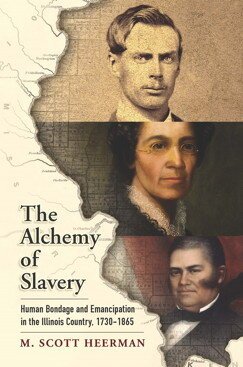From Bondage to Freedom in Illinois Country: On M. Scott Heerman's "The Alchemy of Slavery"
M. Scott Heerman | The Alchemy of Slavery: Human Bondage and Emancipation in the Illinois Country, 1730-1865 | University of Pennsylvania Press | 2018 | 249 Pages
Midwestern history is having a moment. M. Scott Heerman’s new book, The Alchemy of Slavery continues the advance of midwestern scholarship by concentrating on the role of bondage in Illinois’ growth from a French colony in the 1760s to a Northern state struggling to eradicate a series of Black Laws designed to prevent the settlement of African Americans. In tracing the “perpetual reinvention” of bondage in Illinois, Heerman argues that Illinois “masters” forced bondage to evolve and conform to new political realities throughout the Colonial, Early American, and Antebellum eras of American history. Heerman’s book thereby begins with bondage’s colonial origins and argues that nineteenth-century Americans had to grapple with the legacy of French colonial slavery to achieve abolition.
Through the lens of reinvention, Heerman traces how colonial forms of indigenous bondage and Antebellum chattel slavery interacted to force African-descended peoples into bondage despite a constitutional ban. Furthermore, The Alchemy of Slavery looks at how eighteenth-century adaptions shaped slavery and freedom in nineteenth-century America. Heeerman makes it clear that this is a story of bondage—not slavery—because Illinois “lacked [the] institutional trappings,” which is to say that bondage in Illinois was not centered on a chattel framework of personal property, but rather an adaptable system of bonded labor.
One of the most important contributions of the book is its analysis of how colonists formed the class of “French Negroes” in early Illinois. The story starts like most other colonial stories, where the French sought to “Frenchify” the native peoples. Bondage in Illinois’ early history, then, is more of an Atlantic than an American history. Bondage in this period was not “a colonial imposition,” as it was elsewhere. Instead, “Frenchmen found themselves having to adapt to indigenous forms of bondage that pre-dated their arrival.” This system of bondage was defined by alliances between indigenous and French peoples, thereby creating a slave economy operating on negation rather than through power and domination exclusively. It was this system of bondage that haunted nineteenth-century anti-slavery and abolitionist activists because the “French Negroes,” became a constitutionally protected class of bonds people in a state that outlawed slavery. This made abolition much more difficult as this class of people was “a polyglot cast of Indian- and African-descended slaves,” and thus almost impossible to differentiate from other racial classes in the nineteenth-century as the reason for their bondage was that they were property before Illinois became a state.
Bondage continually evolved through the middle of the nineteenth century and Heerman deftly leads readers through colonial bondage’s transformation into American slavery. Bondage continually evolved through the middle of the nineteenth century. But what makes The Alchemy of Slavery significant is that Heerman never lets the reader forget slavery’s colonial heritage as he explains anti-slavery and abolitionist activists’ struggle with the state’s evolving legality of bondage. Abolitionism grew slowly in Illinois. Heerman notes that this was, in part, because anti-slavery activists were forced to continually litigate the freedoms of “the ‘French Negroes’ living in Illinois” as late as the 1840s. Because of this colonial heritage, Illinois’s “freedom politics” looked much different than in other northern states.
The book is not without its faults. Critically, the book fails to make significant mention of black activism. Heerman seems more focused on the role the courts, and thus white-backed abolitionism, in Illinois, but this focus betrays the necessary inclusion of nineteenth-century black activism in the story of bondage. Because of this focus, Illinois’s most prominent black activists hardly appear—and even then, only in the conclusion. Putting African American history on the boundaries of this story is all too familiar in early American historiography. The addition of a chapter on the black state conventions of 1853 and 1856, which were the first meetings of black Illinoisans looking to dismantle the state’s black laws, or John Jones’s, who was the most prominent black activist in pre- and post-war Illinois, would have built toward a better conclusion on emancipation and told a more complete history of the anti-slavery and abolitionist activists in Illinois.
Despite the lack of a deep dive into black activism, The Alchemy of Slavery stands as a great addition to both Midwestern and Illinois historiography. Heerman’s exploration of French colonialism and the continual reinvention of bondage by both British and Americans actors in Illinois expands Antebellum history and further highlights the importance of regional histories. Heerman’s strong bibliography will be crucial for future research into the topic and is a great starting point for younger readers and scholars looking to learn about bondage in Antebellum Illinois.
This review is part of our series on Midwestern history, a collection of reviews on texts of historical significance in the region. Writers interested in contributing to this series are encouraged to contact its editor, Jacob Bruggeman.

